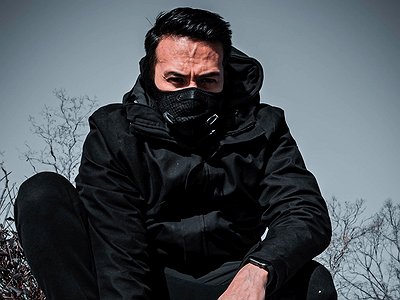Part 1
Name: Laidback Luke / Dark Chanell / Lucas Cornelis van Scheppingen
Nationality: Dutch-Filipino
Occupation: Producer, DJ
Current release: 'No.1', Laidback Luke's first EP under his Dark Channel alias is out now on Mixmash.
Recommendations:
I’ve minimized my reading to one book: The Bible. I’ve fully read it and I’m now reading through it for the second time. I once started it as a sceptic, but I quickly found out why it’s called the Word of God with all the wisdom it holds and with all the lessons you can apply in daily life, helping you with the quality and appreciation of daily life. I know I could be very hip and tell you to read something by Eckhart Tolle, but the Book by the Creator of The Universe has my priority.
One piece of music that I’d love for you to listen is “Love Like a Sunset Part 1 & 2” by Phoenix. When I hear that, I see my whole life flashing before my eyes.
If you enjoyed this interview with Laidback Luke aka Dark Chanell, visit him on Facebook or Soundcloud for more information. Or go straight to his personal website.
When did you start writing/producing music - and what or who were your early passions and influences? What was it about music and/or sound that drew you to it?
I started producing music in 1992, I was 15 years old then. A friend of mine showed me that he was able to make, and manipulate music with an Amiga computer. When I saw that, I knew this was the calling of my life!
I grew up in a musical family but I was always the worst one in the family to be able to play music live. I realized that, with the help of a computer, I could finally make the music that was always stuck in my head. My early passions and influences were The Prodigy, early Dutch Rave compilations and MK.
For most artists, originality is preceded by a phase of learning and, often, emulating others. What was this like for you: How would you describe your own development as an artist and the transition towards your own voice?
This is absolutely correct! In a lot of my productions I just tried to emulate the producers I looked up to. What the beauty is about being yourself: everyone is unique! No matter how much I tried to sound like others, I would always end up sounding like myself. And being that unique individual that we all are, is the strength you’ll always bring.
How do you feel your sense of identity influences your creativity?
It influences it a lot. Even in a time we’ve all been going through, the pandemic and all the mental pressure it brings, I manage to be able to detach from it and just pour my creativity, or frustration into the creation of music. It’s an amazing thing!
What were your main creative challenges in the beginning and how have they changed over time?
My biggest ones were trying to learn all of these hardware synthesizers, samplers, drum computers and FX. Diving into manuals (there were no internet tutorials back then) and going through the various menus, could often take away from creativity. But then there was the mix and mix down after, which could also get very frustrating.
Now, after almost 30 years of producing, all of that is pretty much gone. And it’s amazing to just stay in the creative process without needing to be stopped by the technicalities of digital sound and its interface.
As creative goals and technical abilities change, so does the need for different tools of expression, be it instruments, software tools or recording equipment. Can you describe this path for you, starting from your first studio/first instrument? What motivated some of the choices you made in terms of instruments/tools/equipment over the years?
My first synthesizer ever was a Roland D-5. I remember working all Summer to get it. Before that, my dad’s co-worker owned a Korg M1, which I was able to borrow for a couple of holidays. I never owned it, but the time on that thing has a big place in my heart. My second piece of gear was a Roland W30 sampler which was a game changer! To be able to sample the drum sounds I was always looking for and to be able to take the sounds that I loved, was an incredible step forward.
Fun fact: I was discovered by Gaston from Chocolate Puma, who at that time was doing amazing things on his label Touché under various alter egos. He was setting up a new studio and had a lot of old gear that he wasn’t using so he put that in my bedroom. It was incredible, all of a sudden I had a bunch more synths, effects and a mixing desk as well!
Fun fact 2: I once owned an original Roland TR-909, which I had bought from DJ Sneak! Sneak and that 909, had been a big influence on Daft Punk.
[Read our feature on the Roland TR-909]
Have there been technologies or instruments which have profoundly changed or even questioned the way you make music?
A big transition for me was going from producing out of the box, to producing into the box. I was quite early on this. It was in 2003 that Secret Cinema showed me how he was currently making all his new tracks completely in the box, on just a laptop, using FL Studio (Fruityloops at that time). This was a revolution for me and I decided to sell all my hardware gear for a new laptop and plugins. This is normal now, but back then it was actually a crazy thing to do haha.
Collaborations can take on many forms. What role do they play in your approach and what are your preferred ways of engaging with other creatives through, for example, file sharing, jamming or just talking about ideas?
Interestingly enough, all the above requires quite some social interaction and awkward conversations where some of your creativity is shut down to reach a compromise. A healthy dose of leaving your ego at the door is required in most of the approaches.
I actually enjoy the modern type of collab where you hear a demo, you get the stems, you do your thing with it, and send it back. Sometimes a bit impersonal, but it gives creative freedom and it also preps the ego to brace for possible negative feedback to come back. And then to prepare a good and well thought of response, instead of giving one immediately, possibly through emotion.






